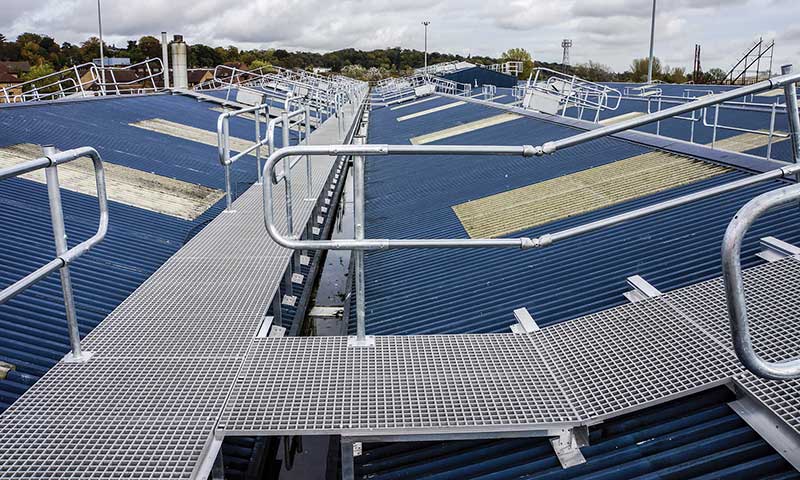Roof walkway systems have become an integral part of modern construction and infrastructure projects. They play a pivotal role in ensuring safety and accessibility for maintenance personnel, contractors, and even building occupants who might need to access rooftops for various reasons. This article delves into the world of roof walkway systems, shedding light on their types, key components, design considerations, installation, maintenance guidelines, and the myriad benefits they offer.
Understanding Roof Walkway Systems
Roof walkway systems are engineered structures designed to provide safe and secure pathways on rooftops. These pathways enable individuals to traverse the rooftop without damaging the surface or compromising safety. They are particularly important on roofs with fragile materials, sloping surfaces, or complex layouts where safe access is challenging. Whether it’s routine maintenance, inspections, or emergency repairs, roof walkway systems, ensure that workers can move efficiently while minimizing risks.
Types Of Roof Walkway Systems
Roof walkway systems come in various forms, each tailored to address specific requirements and challenges of different roofs. Some common types include:
- Grating Walkways: These are robust walkway systems made of metal grating. They provide excellent traction and are suitable for both flat and sloped roofs.
- Aluminum Walkways: Lightweight yet durable, aluminum walkways are corrosion-resistant and can be easily customized to fit various roof configurations.
- Fiberglass Walkways: Ideal for corrosive environments, these walkways are lightweight, non-conductive, and offer a high degree of slip resistance.
- Rubber Walkway Pads: These pads are designed to be placed on existing roof surfaces to create safe pathways. They are particularly useful for protecting the roof membrane and providing a non-slip surface.
- Modular Walkway Systems: These systems consist of interconnected modules that can be assembled to suit the rooftop layout. They offer flexibility and can adapt to changes in the roof structure.
Key Components And Design Considerations
A well-designed roof walkway system comprises several key components to ensure safety and functionality:
- Handrails And Guardrails: These provide vital fall protection and guide individuals along the walkway.
- Support Brackets: These secure the walkway system to the roof surface without damaging the roofing materials.
- Non-Slip Surface: The walkway surface should have a non-slip texture, ensuring secure footing even in wet or icy conditions.
- Anchoring Mechanism: Proper anchoring prevents the walkway from shifting or moving during use.
When designing a roof walkway system, various factors must be considered, including roof slope, load requirements, weather conditions, and the intended use of the walkway. To guarantee that the system successfully mitigates hazards, compliance with relevant safety standards and laws is required.
Installation And Maintenance Guidelines
The installation process of a roof walkway system requires careful planning and precision. Improper installation can lead to compromised safety and functionality. Professionals with expertise in roofing and construction should be enlisted for the installation. The key steps in the installation process include:
- Surface Preparation: The roof surface must be thoroughly cleaned and evaluated for damage or possible risks.
- Positioning: The walkway components should be positioned to align with the desired pathway, and support brackets should be securely attached.
- Anchoring: The walkway system should be properly anchored to prevent movement or dislodging.
- Handrail Installation: Handrails and guardrails should be installed at appropriate heights and securely fastened.
Maintenance of the walkway system is equally important to ensure its longevity and continued safety. Regular inspections should be conducted to identify signs of wear, damage, or degradation. Any problems should be rectified as soon as possible to avoid accidents and retain excellent operation.
Benefits Of Roof Walkway Systems
The implementation of roof walkway systems offers a range of benefits to building owners, maintenance personnel, and occupants:
- Enhanced Safety: Roof walkway systems offer employees safe passageways, lowering the danger of accidents and falls, particularly on slick or unstable surfaces.
- Prevent Roof Damage: By providing designated pathways, these systems prevent unnecessary foot traffic on sensitive roof areas, minimizing the potential for damage to roofing materials.
- Ease Of Access: Roof walkways make it easier for maintenance crews to access rooftop equipment, conduits, and other components for repairs and inspections.
- Compliance: Many industries are subject to strict safety regulations. Roof walkway systems help organizations comply with these regulations, avoiding potential legal and financial consequences.
- Longevity Of Roof: By minimizing direct contact with the roof surface, these systems can extend the lifespan of the roof, reducing the frequency of repairs and replacements.
Adaptability: Modular walkway systems can be customized to fit various roof layouts, providing adaptability to changing needs.

